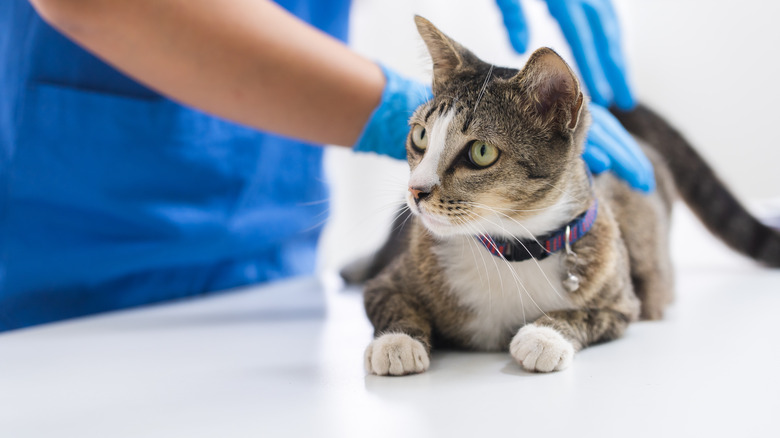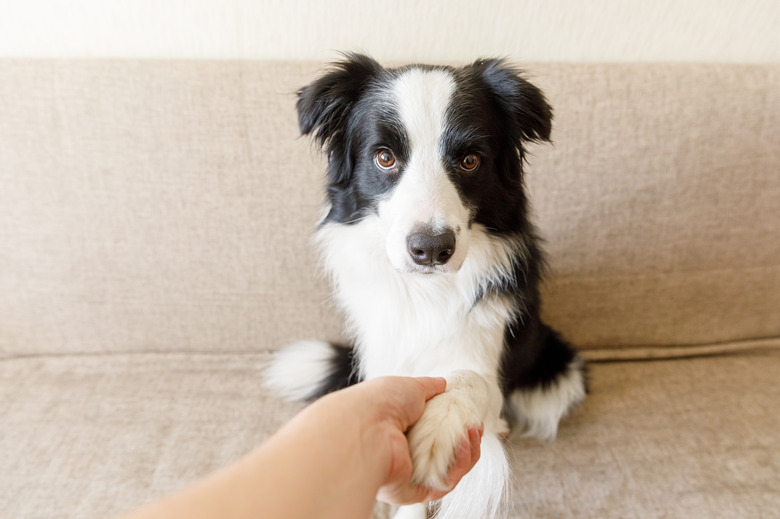Cooperative Care: How To Make Vet Visits Less Stressful For Your Pet
We may receive a commission on purchases made from links.
Do you dread needing to take your dog to the vet or spend time grooming your dog? This necessary treatment is often very scary and upsetting to our dogs. Cooperative care is a new approach to training and working with animals that hallows our dogs (and other pets) to be active and willing participants in their care and grooming.
What is cooperative care?
What is cooperative care?
Sometimes called "husbandry training," cooperative care is an approach to working with animals that is reliant upon their consent and involvement instead of being forced to participate. It is specifically used for necessary treatments like nail trimming, ear cleaning, etc.
Husbandry training/cooperative care gives our dogs the opportunity to participate by offering parts of their body to be examined, trimmed, cleaned, or touched, instead of having to be manually manipulated. Husbandry training has roots in the modern work done with animals in zoos, where animals including large predators are taught through positive reinforcement approaches to provide specific body parts to keepers or vets for examination or treatment. This eliminates or reduces the need for sedation or restraint, making the procedures safer and less stressful for the animals.
Although it might seem impossible to think about your dog offering their foot for a nail trim, if zookeepers can teach large predators like lions and polar bears to be cooperative and engaged in their own veterinary care, it's no surprise we can do the same things at home with our own pets.
Stress reducing benefits of cooperative care
Stress reducing benefits of cooperative care
Cooperative care techniques make veterinary care, grooming, and at-home treatments less stressful for your dog and for you. Cooperative care is a training and lifestyle approach and methodology that is designed to give you and your dog the skills to work together, and for your dog to consent to treatment, and be engaged in treatment. Cooperative care isn't just teaching your dog to do something on your cue, it's about building a mutually respect filled relationship that gives your dog the opportunity to opt into treatment which makes treatment less stressful for our dogs and for us.
For example, if you have a dog who is very uncomfortable having their paws touched, it's likely that nail trimmings are something that you struggle with. In some of these situations, owners may take their dog to a vet or groomer to have the procedure done—often involving the dog being forcibly restrained, which generally increases the fear the dog was already feeling around the procedure.
Instead, a cooperative care approach would look like slowly shaping a new behavior such as rewarding your dog for giving you their paw, then slowly building up to the presence of the clippers or a dremel, then your dog choosing to give you their paw as he dremel or clippers touch their paw but don't trim a nail, then your dog choosing to give you a paw and allow you to trip a nail, and so forth until you're able to properly trim each foot.
The Fear Free approach
The Fear Free approach
Working hand in hand with cooperative care approaches is the framework. This is an educational and certification program that supports animal care professionals including veterinarians to create clinic environments that are both physically and emotionally safe for pets. The Fear Free certification program was developed in 2016 by Dr. Marty Becker, DVM. Veterinarians committed to Fear Free principles are focused on making the entire experience of visiting the vet less stressful for dogs by reducing a dog's overall anxiety around visiting the vet. For some dogs, this looks like anti-anxiety medication and use of calming pheromones.)
Fear Free clinics will also limit a dog's interactions with slippery floors by bringing in blankets, yoga mats, and/or carpeting into examination areas so that dogs are able to comfortably get their footing in the clinic. Fear free principles make vet visits look different than what many of us have seen in "traditional" vet visits. These visits focus on the dog's overall comfort and stress levels in addition to whatever physical condition that led to the visit being scheduled. The priority is to use calming techniques, as well as treats and training to invite and encourage dogs to be part of their examinations and treatment instead of being forced or restrained into compliance. If at any time, you feel like your vet is moving too quickly for your dog's comfort you can advocate for your dog by asking for the appointment to move more slowly and say that you're utilizing fear free practices. Even if your vet/vet clinic isn't (yet) certified Fear Free, many clinics understand that terminology and will generally be willing to adjust their practices to work with your training plans and your dog's comfort. (If they are not, it may be time to find another vet.)
Cooperative chin rests
Cooperative chin rests
Cooperative care should be voluntary on behalf of your dog not forced by being coerced or restrained. One way to begin introducing cooperative care techniques is to create opportunities for your dog to opt into treatments. For example when you take your dog to the vet you can use (dog safe) peanut butter spread on the floor, a plate, LikiMat for extra enrichment. This gives the dog something enriching to do while they are being examined, getting vaccinations etc.
A common technique to incorporate with this is to teach dog's a chin rest. This versatile foundation skill involves a dog placing their chin into their owner's hand. With practice, this behavior is useful for encouraging dogs to remain still for a short period of time during an exam, or for grooming or vet procedures. Your dog will learn that by holding the chin rest position at first while licking or eating treats. Over time you can build the duration your dog holds the chin rest. And your dog will learn they control the procedure (nail trim, ear cleaning, etc.) and consent to it happening: When your dog lifts their head from the chin rest position the procedure stops (and the treats go away. When your dog puts their head back down into a chin rest, the treats return.
Learning more
Learning more
Many positive reinforcement dog trainers are increasingly offering cooperative care classes, clinics, or private coaching sessions. Here you'll get skills for how to learn to read your dog and understand when your dog is consenting, and how to develop a shared language which can allow you to do a variety of grooming and veterinary procedures from nail trims and ear cleans to more advanced techniques like eye drop administering and even blood draws and vaccines. The ClickerExpo, an annual dog training conference (virtual in 2022) generally has education tracks focused on teaching cooperative care techniques. You can search for Fear Free certified professionals, vets and more in your local area via their online directory. You and your dog can even earn Cooperative Care certificates at home via the Cooperative Care Certificate program that provides a structured training opportunity via their virtual titling program that helps dog owners and their dogs explore cooperative are techniques for grooming and vet visits at home.
Most dogs will take to cooperative care techniques and training right away. These are skills you can start utilizing with grooming and veterinary procedures your dog is neutral or ambivalent about, and as you get more experienced you can work up to treatments your dog is less comfortable with. Cooperative Care techniques can be utilized at home, at the groomer, and at the vet to make treatment and grooming less stressful for your dog by involving them in their own treatment.



